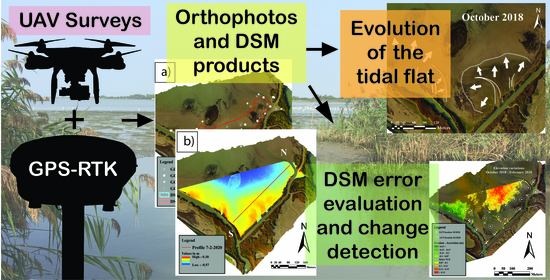Evaluating Short-Term Tidal Flat Evolution Through UAV Surveys: A Case Study in the Po Delta (Italy)
Abstract
:1. Introduction
2. Study Site
3. Materials and Methods
3.1. Fieldworks
3.2. Photogrammetric Tests
3.3. Validation of the DSMs
3.4. Comparisons between Photogrammetric Tests
3.5. DEM of Difference: Evolution of the Area
3.6. Significance of the Vertical Differences
3.7. Integrated Geomorphological Interpretation
4. Results
4.1. Tidal Flat Morphology
4.2. Differences due to DSM Resolution
4.3. DSM Error Assessment
4.4. Differences Due to Flight Altitude
4.5. Morphological Changes
5. Discussion
5.1. Morphodynamic Interpretation
5.1.1. Tidal Flat Evolution
5.1.2. Comparisons with Other Microtidal Flats
5.2. UAV-based Tidal Flat Monitoring
5.2.1. Field Implementation and DSM Error Assessment
5.2.2. UAV-based Morphodynamic Assessment and Uncertainty
5.2.3. Comparisons with Other Studies with UAV in Wetlands
5.2.4. Recommendations for UAV surveys in wetlands
- The fieldwork should be planned in the function of the expected rate of changes and the time between each survey based on the knowledge of the area;
- A comparison with ground-truthing (e.g., vs. GPS) is always recommended;
- 2–3 GCPs should be located every 100 m homogeneously and equally distributed in order to reach centimetric RMSE;
- The flight can be carried out at 80–100 m altitude to save time but the altitude must be kept constant for the whole monitored period;
- The fieldwork should be carried out during the early morning or late afternoon time slots, and with cloudy weather when a spring low tide occurs.
6. Conclusions
- During the last phase part of the winter season and the spring–summer season of 2018–2019, the study area experienced erosion while in the autumn–winter season of 2019–2020 an accretion trend was predominant. Timewise, the increase and the widening of the tidal flat coincide with the heavy flood events occurring in the Po River during November–December 2019;
- Overall, the sediment budget is positive, and the tidal flat is gaining ~800 m3/year with an average accretion rate of 1.3 cm/year (by considering the significant variations those values become 420 ± 385 m3/year and 5.2 ± 4.8 cm/year, respectively);
- The accretion trends of the tidal flat of Pila are similar to other microtidal deltas worldwide; most of them are characterised by seasonal variations that depend on episodic events (i.e., floods, storms) and do not present constant trends like tide-dominated deltas.
Author Contributions
Funding
Data Availability Statement
Acknowledgments
Conflicts of Interest
References
- Dyer, K.; Christie, M.; Wright, E. The classification of intertidal mudflats. Cont. Shelf Res. 2000, 20, 1039–1060. [Google Scholar] [CrossRef]
- Pratolongo, P.; Leonardi, N.; Kirby, J.R.; Plater, A. Temperate Coastal Wetlands. In Coastal Wetlands; Elsevier: Amsterdam, The Netherlands, 2019; pp. 105–152. [Google Scholar]
- French, J.R. Saltmarshes: Morphodynamics, Conservation and Engineering Significance; Allen, J.R.L., Pye, K., Eds.; Cambridge University Press: Cambridge, UK, 1992. [Google Scholar]
- Adam, P. Plant Life History Studies; Cambridge University Press: Cambridge, UK, 1990; pp. 309–334. [Google Scholar]
- Odum, W.E.; McIvor, C.C.; Smith, T.J. The Ecology of the Mangroves of South Florida: A Community Profile. U.S. Fish and Wildlife Service; Office of Biological Services: Washington, DC, USA, 1982; p. 156. [Google Scholar]
- Christiansen, T.; Wiberg, P.; Milligan, T. Flow and Sediment Transport on a Tidal Salt Marsh Surface. Estuar. Coast. Shelf Sci. 2000, 50, 315–331. [Google Scholar] [CrossRef] [Green Version]
- Leonard, L.A.; Wren, P.A.; Beavers, R.L. Flow Dynamics and Sedimentation in Spartina alterniflora and Phragmites australis marshes of the Chesapeake Bay. Wetlands 2002, 22, 415–424. [Google Scholar] [CrossRef]
- Temmerman, S.; Govers, G.; Wartel, S.; Meire, P. Modelling estuarine variations in tidal marsh sedimentation: Response to changing sea level and suspended sediment concentrations. Mar. Geol. 2004, 212, 1–19. [Google Scholar] [CrossRef]
- Boesch, D.F.; Turner, R.E. Dependence of Fishery Species on Salt Marshes: The Role of Food and Refuge. Estuaries 1984, 7, 460–468. [Google Scholar] [CrossRef]
- MacKenzie, R.; Dionne, M. Habitat heterogeneity: Importance of salt marsh pools and high marsh surfaces to fish production in two Gulf of Maine salt marshes. Mar. Ecol. Prog. Ser. 2008, 368, 217–230. [Google Scholar] [CrossRef]
- Barbier, E.B.; Hacker, S.D.; Kennedy, C.; Koch, E.W.; Stier, A.C.; Silliman, B.R. The value of estuarine and coastal ecosystem services. Ecol. Monogr. 2011, 81, 169–193. [Google Scholar] [CrossRef]
- Mayor, J.R.; Hicks, C.E. Potential Impacts of Elevated CO2 on Plant Interactions, Sustained Growth, and Carbon Cycling in Salt Marsh Ecosystems, Human Impacts on Salt Marshes A Global Perspective; Silliman, B.R., Grosholz, E.D., Bertness, M.D., Eds.; University of California: Berkeley, CA, USA, 2009; pp. 207–228. [Google Scholar]
- Weis, P. Salt Marsh Accretion. In Encyclopedia of Solid Earth Geophysics; Springer: Berlin/Heidelberg, Germany, 2016; pp. 513–515. [Google Scholar]
- Bouma, T.J.; van Belzen, J.; Balke, T.; Zhu, Z.; Airoldi, L.; Blight, A.J.; Davies, A.J.; Galvan, C.; Hawkins, S.J.; Hoggart, S.P.; et al. Identifying knowledge gaps hampering application of intertidal habitats in coastal protection: Opportunities & steps to take. Coast. Eng. 2014, 87, 147–157. [Google Scholar] [CrossRef]
- Möller, I.; Kudella, M.; Rupprecht, F.; Spencer, T.; Paul, M.; Van Wesenbeeck, B.K.; Wolters, G.; Jensen, K.; Bouma, T.J.; Miranda-Lange, M.; et al. Wave attenuation over coastal salt marshes under storm surge conditions. Nat. Geosci. 2014, 7, 727–731. [Google Scholar] [CrossRef] [Green Version]
- Van Loon-Steensma, J.M. Salt Marshes for Flood Protection; Wageningen University: Wageingen, The Netherlands, 2014; p. 203. [Google Scholar]
- Smolders, S.; Plancke, Y.; Ides, S.; Meire, P.; Temmerman, S. Role of intertidal wetlands for tidal and storm tide attenuation along a confined estuary: A model study. Nat. Hazards Earth Syst. Sci. 2015, 15, 1659–1675. [Google Scholar] [CrossRef] [Green Version]
- Stark, J.; Van Oyen, T.; Meire, P.; Temmerman, S. Observations of tidal and storm surge attenuation in a large tidal marsh. Limnol. Oceanogr. 2015, 60, 1371–1381. [Google Scholar] [CrossRef]
- Vuik, V.; Jonkman, S.N.; Van Vuren, S. Nature-based flood protection: Using vegetated foreshores for reducing coastal risk. E3S Web Conf. 2016, 7, 13014. [Google Scholar] [CrossRef] [Green Version]
- Leonardi, N.; Carnacina, I.; Donatelli, C.; Ganju, N.; Plater, A.J.; Schuerch, M.; Temmerman, S. Dynamic interactions between coastal storms and salt marshes: A review. Geomorphology. 2018, 301, 92–107. [Google Scholar] [CrossRef] [Green Version]
- Millennium Ecosystem Assessment. Ecosystems and Human Well-Being: Synthesis; Island Press: Washington, DC, USA, 2005. [Google Scholar]
- Eisenbeiss, H. UAV Photogrammetry 2009. Ph.D. Thesis, ETH Zürich, Zürich, Switzerland, 2009. [Google Scholar]
- Westoby, M.J.; Brasington, J.; Glasser, N.F.; Hambrey, M.J.; Reynolds, J.M. Structure-from-Motion photogrammetry: A low-cost, effective tool for geoscience applications. Geomorphology 2012, 179, 300–314. [Google Scholar] [CrossRef] [Green Version]
- Moloney, J.G.; Hilton, M.J.; Sirguey, P.; Simons-Smith, T. Coastal Dune Surveying Using a Low-Cost Remotely Piloted Aerial System (RPAS). J. Coast. Res. 2018, 345, 1244–1255. [Google Scholar] [CrossRef]
- Mancini, F.; Dubbini, M.; Gattelli, M.; Stecchi, F.; Fabbri, S.; Gabbianelli, G. Using Unmanned Aerial Vehicles (UAV) for High-Resolution Reconstruction of Topography: The Structure from Motion Approach on Coastal Environments. Remote Sens. 2013, 5, 6880–6898. [Google Scholar] [CrossRef] [Green Version]
- Joyce, K.E.; Duce, S.; Leahy, S.M.; Leon, J.; Maier, S.W. Principles and practice of acquiring drone-based image data in marine environments. Mar. Freshw. Res. 2019, 70, 952–963. [Google Scholar] [CrossRef]
- Javernick, L.; Brasington, J.; Caruso, B. Modeling the topography of shallow braided rivers using Structure-from-Motion photogrammetry. Geomorphology 2014, 213, 166–182. [Google Scholar] [CrossRef]
- Ryan, J.C.; Hubbard, A.L.; Box, J.; Todd, J.; Christoffersen, P.; Carr, J.R.; Holt, T.O.; Snooke, N. UAV photogrammetry and structure from motion to assess calving dynamics at Store Glacier, a large outlet draining the Greenland ice sheet. Cryosphere 2015, 9, 1–11. [Google Scholar] [CrossRef] [Green Version]
- Casella, E.; Rovere, A.; Pedroncini, A.; Stark, C.P.; Casella, M.; Ferrari, M.; Firpo, M. Drones as tools for monitoring beach topography changes in the Ligurian Sea (NW Mediterranean). Geo Lett. 2016, 36, 151–163. [Google Scholar] [CrossRef]
- Dąbski, M.; Zmarz, A.; Pabjanek, P.; Korczak-Abshire, M.; Karsznia, I.; Chwedorzewska, K.J. UAV-based detection and spatial analyses of periglacial landforms on Demay Point (King George Island, South Shetland Islands, Antarctica). Geomorphology 2017, 290, 29–38. [Google Scholar] [CrossRef]
- Duo, E.; Trembanis, A.C.; Dohner, S.; Grottoli, E.; Ciavola, P. Local-scale post-event assessments with GPS and UAV-based quick-response surveys: A pilot case from the Emilia–Romagna (Italy) coast. Nat. Hazards Earth Syst. Sci. 2018, 18, 2969–2989. [Google Scholar] [CrossRef] [Green Version]
- Klemas, V.V. Remote Sensing of Coastal Ecosystems and Environments. In Coastal Wetlands: Alteration and Remediation; Springer: Berlin/Heidelberg, Germany, 2014; Volume 9, pp. 3–30. [Google Scholar]
- Adam, E.; Mutanga, O.; Rugege, D. Multispectral and hyperspectral remote sensing for identification and mapping of wetland vegetation: A review. Wetl. Ecol. Manag. 2010, 18, 281–296. [Google Scholar] [CrossRef]
- Ghosh, S.; Mishra, D.R. Analyzing the Long-Term Phenological Trends of Salt Marsh Ecosystem across Coastal Louisiana. Remote Sens. 2017, 9, 1340. [Google Scholar] [CrossRef] [Green Version]
- Duffy, J.P.; Pratt, L.; Anderson, K.; Land, P.E.; Shutler, J.D. Spatial assessment of intertidal seagrass meadows using optical imaging systems and a lightweight drone. Estuar. Coast. Shelf Sci. 2018, 200, 169–180. [Google Scholar] [CrossRef]
- Doughty, C.L.; Cavanaugh, K.C. Mapping Coastal Wetland Biomass from High Resolution Unmanned Aerial Vehicle (UAV) Imagery. Remote Sens. 2019, 11, 540. [Google Scholar] [CrossRef] [Green Version]
- Ozesmi, S.L.; Bauer, M.E. Satellite remote sensing of wetlands. Wetl. Ecol. Manag. 2002, 10, 381–402. [Google Scholar] [CrossRef]
- Campbell, A.; Wang, Y. High Spatial Resolution Remote Sensing for Salt Marsh Mapping and Change Analysis at Fire Island National Seashore. Remote Sens. 2019, 11, 1107. [Google Scholar] [CrossRef] [Green Version]
- Morris, J.T.; Porter, D.; Neet, M.; Noble, P.A.; Schmidt, L.; Lapine, L.A.; Jensen, J.R. Integrating LIDAR elevation data, multi-spectral imagery and neural network modelling for marsh characterization. Int. J. Remote Sens. 2005, 26, 5221–5234. [Google Scholar] [CrossRef]
- Rosso, P.; Ustin, S.; Hastings, A. Use of lidar to study changes associated with Spartina invasion in San Francisco Bay marshes. Remote Sens. Environ. 2006, 100, 295–306. [Google Scholar] [CrossRef]
- Wang, C.; Menenti, M.; Stoll, M.-P.; Feola, A.; Belluco, E.; Marani, M. Separation of Ground and Low Vegetation Signatures in LiDAR Measurements of Salt-Marsh Environments. IEEE Trans. Geosci. Remote Sens. 2009, 47, 2014–2023. [Google Scholar] [CrossRef]
- Millard, K.; Redden, A.M.; Webster, T.; Stewart, H. Use of GIS and high resolution LiDAR in salt marsh restoration site suitability assessments in the upper Bay of Fundy, Canada. Wetl. Ecol. Manag. 2013, 21, 243–262. [Google Scholar] [CrossRef]
- Fernandez-Nunez, M.; Burningham, H.; Zujar, J.O. Improving accuracy of LiDAR-derived digital terrain models for saltmarsh management. J. Coast. Conserv. 2017, 21, 209–222. [Google Scholar] [CrossRef]
- Nolte, S.; Koppenaal, E.C.; Esselink, P.; Dijkema, K.S.; Schuerch, M.; De Groot, A.V.; Bakker, J.P.; Temmerman, S. Measuring sedimentation in tidal marshes: A review on methods and their applicability in biogeomorphological studies. J. Coast. Conserv. 2013, 17, 301–325. [Google Scholar] [CrossRef]
- Green, D.; Mauquoy, D.; Hagon, J.; Angus, S.; Hansom, J.; Rennie, A.; Gourlay, C. Monitoring, Mapping and Modelling Saltmarsh: The UAV Way; Geomares Publishing UK Ltd: St. Albans, UK, 2017; pp. 22–28. [Google Scholar]
- Kalacska, M.; Chmura, G.; Lucanus, O.; Bérubé, D.; Arroyo-Mora, J. Structure from motion will revolutionize analyses of tidal wetland landscapes. Remote Sens. Environ. 2017, 199, 14–24. [Google Scholar] [CrossRef]
- Casella, E.; Drechsel, J.; Winter, C.; Benninghoff, M.; Rovere, A. Accuracy of sand beach topography surveying by drones and photogrammetry. Geo-Mar. Lett. 2020, 40, 255–268. [Google Scholar] [CrossRef] [Green Version]
- James, M.; Robson, S.; D’Oleire-Oltmanns, S.; Niethammer, U. Optimising UAV topographic surveys processed with structure-from-motion: Ground control quality, quantity and bundle adjustment. Geomorphology 2017, 280, 51–66. [Google Scholar] [CrossRef] [Green Version]
- Mount, R. Acquisition of Through-water Aerial Survey Images. Photogramm. Eng. Remote Sens. 2005, 71, 1407–1415. [Google Scholar] [CrossRef]
- Nardin, W.; Edmonds, D.A. Optimum vegetation height and density for inorganic sedimentation in deltaic marshes. Nat. Geosci. 2014, 7, 722–726. [Google Scholar] [CrossRef]
- Crosby, S.C.; Sax, D.F.; Palmer, M.E.; Booth, H.S.; Deegan, L.A.; Bertness, M.D.; Leslie, H.M. Salt marsh persistence is threatened by predicted sea-level rise. Estuar. Coast. Shelf Sci. 2016, 181, 93–99. [Google Scholar] [CrossRef] [Green Version]
- Spencer, T.; Schuerch, M.; Nicholls, R.J.; Hinkel, J.; Lincke, D.; Vafeidis, A.; Reef, R.; McFadden, L.; Brown, S. Global coastal wetland change under sea-level rise and related stresses: The DIVA Wetland Change Model. Glob. Planet. Chang. 2016, 139, 15–30. [Google Scholar] [CrossRef] [Green Version]
- Kirwan, M.L.; Temmerman, S.; Skeehan, M.L.K.E.E.; Guntenspergen, G.R.; Fagherazzi, S. Overestimation of marsh vulnerability to sea level rise. Nat. Clim. Chang. 2016, 6, 253–260. [Google Scholar] [CrossRef]
- Cencini, C. Physical Processes and Human Activities in the Evolution of the Po Delta, Italy. J. Coast. Res. 1998, 14, 774–793. [Google Scholar] [CrossRef]
- Simeoni, U.; Corbau, C. A review of the Delta Po evolution (Italy) related to climatic changes and human impacts. Geomorphology 2009, 107, 64–71. [Google Scholar] [CrossRef]
- Bondesan, M. L’area deltizia padana: Caratteri geografici e geomorfologici. In Il Parco del Delta del po. Studi e Immagini. L’ambiente Come Risorsa; Spazio Libri: Ferrara, Italy, 1990; Volume 16, pp. 10–48. [Google Scholar]
- Ludwig, W.; Dumont, E.; Meybeck, M.; Heussner, S. River discharges of water and nutrients to the Mediterranean and Black Sea: Major drivers for ecosystem changes during past and future decades? Prog. Oceanogr. 2009, 80, 199–217. [Google Scholar] [CrossRef]
- Dal Cin, R.I. Litorali Del Delta Del Po e Alle Fois Dell’ Adige e Del Brenta: Caratteri Tessiturali e Dispersione Dei Sedimenti, Cause Dell’arretramento e Preisioni Sull’ Evoluzione Futura. Boll. Soc. Geol. Ital. 1983, 102, 9–56. [Google Scholar]
- Simeoni, U.; Fontolan, G.; Dal Cin, R.; Calderoni, G.; Zamariolo, A. Dinamica sedimentaria dell’area di Goro (Delta del Po). Studi Costieri 2000, 2, 139–151. [Google Scholar]
- Simeoni, U.; Gabbianelli, G.; Tessari, U.; Calderoni, G.; Grande, C. Un Bacile di nome Delta. La Sacca di Goro. Studi Costieri 2000, 2, 31–44. [Google Scholar]
- Stefani, M.; Vincenzi, S. The interplay of eustasy, climate and human activity in the late Quaternary depositional evolution and sedimentary architecture of the Po Delta system. Mar. Geol. 2005, 222-223, 19–48. [Google Scholar] [CrossRef]
- Maselli, V.; Trincardi, F. Man made deltas. Sci. Rep. 2013, 3, 1926. [Google Scholar] [CrossRef] [Green Version]
- Visentini, M. Ricerche Idrografiche nel Delta del Po. Ufficio Idrografico del Po-Parma; Istituto Poligrafico Dello Stato: Roma, Italy, 1940; Volume 14, p. 175. [Google Scholar]
- Billi, P.; Fazzini, M. Global change and river flow in Italy. Glob. Planet. Chang. 2017, 155, 234–246. [Google Scholar] [CrossRef]
- Ninfo, A.; Ciavola, P.; Billi, P. The Po Delta is restarting progradation: Geomorphological evolution based on a 47-years Earth Observation dataset. Sci. Rep. 2018, 8, 1–6. [Google Scholar] [CrossRef] [PubMed] [Green Version]
- Smith, A.E. Modern deltas: Comparison maps. In Deltas in Their Geologic Framework, Houston; Shirley, M.L., Ed.; Houston Geological Society: Houston, TX, USA, 1966; p. 223. [Google Scholar]
- Nelson, B.W. Hydrography, Sediment Dispersal, and Recent Historical Development of the Po River Delta, Italy. In Deltaic Sedimentation, Modern and Ancient; Morgan, J.P., Shaver, R.H., Eds.; SEPM Society for Sedimentary Geology: Tulsa, OK, USA, 1970; Volume 15, pp. 152–184. [Google Scholar]
- Galloway, W. Process Framework for Describing the Morphologic and Stratigraphic Evolution of Deltaic Depositional System; Society of Economic Paleontologists and Mineralogist (SEPM): Broken Arrow, OK, USA, 1975. [Google Scholar]
- Reineck, P.D.H.-E.; Singh, I.B. Depositional Sedimentary Environments; Springer: Berlin/Heidelberg, Germany, 1980; Volume 19, p. 551. [Google Scholar]
- Trincardi, F.; Cattaneo, A.; Correggiari, A. Mediterranean Prodelta, Systems Natural Evolution and Human Impact. Ocean-ography 2003, 17, 37–45. [Google Scholar]
- Syvitski, J.P.; Kettner, A.J.; Correggiari, A.; Nelson, B.W. Distributary channels and their impact on sediment dispersal. Mar. Geol. 2005, 222–223, 75–94. [Google Scholar] [CrossRef]
- Correggiari, A.; Cattaneo, A.; Trincardi, F. The modern Po Delta system: Lobe switching and asymmetric prodelta growth. Mar. Geol. 2005, 222–223, 49–74. [Google Scholar] [CrossRef]
- Fonstad, M.A.; Dietrich, J.; Courville, B.C.; Jensen, J.L.; Carbonneau, P.E. Topographic structure from motion: A new development in photogrammetric measurement. Earth Surf. Process. Landf. 2013, 38, 421–430. [Google Scholar] [CrossRef] [Green Version]
- Casella, E.; Rovere, A.; Pedroncini, A.; Mucerino, L.; Casella, M.; Cusati, L.A.; Vacchi, M.; Ferrari, M.; Firpo, M. Study of wave runup using numerical models and low-altitude aerial photogrammetry: A tool for coastal management. Estuar. Coast. Shelf Sci. 2014, 149, 160–167. [Google Scholar] [CrossRef]
- Gindraux, S.; Boesch, R.; Farinotti, D. Accuracy Assessment of Digital Surface Models from Unmanned Aerial Vehicles’ Imagery on Glaciers. Remote Sens. 2017, 9, 186. [Google Scholar] [CrossRef] [Green Version]
- Wheaton, J.M.; Brasington, J.; Darby, S.E.; Sear, D.A. Accounting for uncertainty in DEMs from repeat topographic surveys: Improved sediment budgets. Earth Surf. Process. Landf. 2010, 35, 136–156. [Google Scholar] [CrossRef]
- Lane, S.N.; Westaway, R.M.; Hicks, D.M. Estimation of erosion and deposition volumes in a large, gravel-bed, braided river using synoptic remote sensing. Earth Surf. Process. Landf. 2003, 28, 249–271. [Google Scholar] [CrossRef]
- Milan, D.J.; Heritage, G.; Hetherington, D. Application of a 3D laser scanner in the assessment of erosion and deposition volumes and channel change in a proglacial river. Earth Surf. Process. Landf. 2007, 32, 1657–1674. [Google Scholar] [CrossRef]
- Tesi, T.; Miserocchi, S.; Goni, M.; Turchetto, M.; Langone, L.; De Lazzari, A.; Albertazzi, S.; Correggiari, A. Influence of distributary channels on sediment and organic matter supply in event-dominated coastal margins: The Po prodelta as a study case. Biogeosciences 2011, 8, 365–385. [Google Scholar] [CrossRef] [Green Version]
- Palinkas, C.; Nittrouer, C.; Wheatcroft, R.; Langone, L. The use of 7Be to identify event and seasonal sedimentation near the Po River delta, Adriatic Sea. Mar. Geol. 2005, 222–223, 95–112. [Google Scholar] [CrossRef]
- D’Alpaos, A.; Lanzoni, S.; Mudd, S.M.; Fagherazzi, S. Modeling the influence of hydroperiod and vegetation on the cross-sectional formation of tidal channels. Estuar. Coast. Shelf Sci. 2006, 69, 311–324. [Google Scholar] [CrossRef]
- Geng, L.; Gong, Z.; Zhou, Z.; Lanzoni, S.; D’Alpaos, A. Assessing the relative contributions of the flood tide and the ebb tide to tidal channel network dynamics. Earth Surf. Process. Landf. 2020, 45, 237–250. [Google Scholar] [CrossRef]
- Verney, R.; Deloffre, J.; Brun-Cottan, J.-C.; Lafite, R. The effect of wave-induced turbulence on intertidal mudflats: Impact of boat traffic and wind. Cont. Shelf Res. 2007, 27, 594–612. [Google Scholar] [CrossRef] [Green Version]
- Andersen, T.; Pejrup, M.; Nielsen, A. Long-term and high-resolution measurements of bed level changes in a temperate, microtidal coastal lagoon. Mar. Geol. 2006, 226, 115–125. [Google Scholar] [CrossRef] [Green Version]
- Frostick, L.E.; McCave, I. Seasonal shifts of sediment within an estuary mediated by algal growth. Estuar. Coast. Mar. Sci. 1979, 9, 569–576. [Google Scholar] [CrossRef]
- Wood, N.; Hine, A.C. Spatial Trends in Marsh Sediment Deposition Within a Microtidal Creek System, Waccasassa Bay, Florida. J. Coast. Res. 2007, 234, 823–833. [Google Scholar] [CrossRef]
- Goodbred, S.L.; Hine, A.C. Coastal storm deposition: Salt-marsh response to a severe extratropical storm, March 1993, west-central Florida. Geology 1995, 23, 679–682. [Google Scholar] [CrossRef]
- Wood, N.J.; Hine, A.C. Sediment Dynamics of a Sediment-Starved, Open-Marine Marsh Embayment: Waccasassa Bay, Florida. J. Coast. Res. 2003, 19, 574–583. [Google Scholar]
- Day, J.W.; Rismondo, A.; Scarton, F.; Are, D.; Cecconi, G. Relative sea level rise and Venice lagoon wetlands. J. Coast. Conserv. 1998, 4, 27–34. [Google Scholar] [CrossRef]
- Scarton, F.; Day, J.W.; Rismondo, A.; Cecconi, G.; Are, D. Effects of an intertidal sediment fence on sediment elevation and vegetation distribution in a Venice (Italy) lagoon salt marsh. Ecol. Eng. 2000, 16, 223–233. [Google Scholar] [CrossRef]
- Ciavola, P.; Organo, C.; Vintró, L.L.; Mitchell, P. Sedimentation Processes on Intertidal Areas of the Lagoon of Venice: Identification of Exceptional Flood Events (Acqua Alta) Using Radionuclides. J. Coast. Res. 2002, 36, 139–147. [Google Scholar] [CrossRef]
- Pethick, J.S. Long-term Accretion Rates on Tidal Salt Marshes. J. Sediment. Res. 1981, 51. [Google Scholar] [CrossRef]
- Dora, G.U.; Kumar, V.S.; Vinayaraj, P.; Philip, C.; Johnson, G. Quantitative estimation of sediment erosion and accretion processes in a micro-tidal coast. Int. J. Sediment Res. 2014, 29, 218–231. [Google Scholar] [CrossRef]
- White, W.; Morton, R.; Holmes, C.W. A comparison of factors controlling sedimentation rates and wetland loss in fluvial–deltaic systems, Texas Gulf coast. Geomorphology 2002, 44, 47–66. [Google Scholar] [CrossRef]
- Hatton, R.S.; Delaune, R.D.; Patrick, W.H. Sedimentation, accretion, and subsidence in marshes of Barataria Basin, Louisiana. Limnol. Oceanogr. 1983, 28, 494–502. [Google Scholar] [CrossRef]
- Jankowski, K.L.; Törnqvist, T.; Fernandes, A.M. Vulnerability of Louisiana’s coastal wetlands to present-day rates of relative sea-level rise. Nat. Commun. 2017, 8, 14792. [Google Scholar] [CrossRef] [Green Version]
- Paola, C.; Twilley, R.R.; Edmonds, D.A.; Kim, W.; Mohrig, D.; Parker, G.; Viparelli, E.; Voller, V.R. Natural Processes in Delta Restoration: Application to the Mississippi Delta. Annu. Rev. Mar. Sci. 2011, 3, 67–91. [Google Scholar] [CrossRef]
- Yellen, B.; Woodruff, J.; Ladlow, C.; Ralston, D.; Fernald, S.; Lau, W. Rapid tidal marsh development in anthropogenic backwaters. Earth Surf. Process. Landf. 2021, 46, 554–572. [Google Scholar] [CrossRef]
- Hensel, P.E., Jr.; Pont, D. Wetland Vertical Accretion and Soil Elevation Change in the Rhône River Delta, France: The Importance of Riverine Flooding. J. Coast. Res. 1999, 15, 668–681. [Google Scholar]
- Ibáñez, C.; Sharpe, P.J.; Day, J.W.; Day, J.N.; Prat, N. Vertical Accretion and Relative Sea Level Rise in the Ebro Delta Wetlands (Catalonia, Spain). Wetlands 2010, 30, 979–988. [Google Scholar] [CrossRef]
- Day, J.; Ibáñez, C.; Scarton, F.; Pont, D.; Hensel, P.; Day, J.; Lane, R. Sustainability of Mediterranean Deltaic and Lagoon Wetlands with Sea-Level Rise: The Importance of River Input. Chesap. Sci. 2011, 34, 483–493. [Google Scholar] [CrossRef]
- Cahoon, D.R.; Reed, D.J.; Day, J.W., Jr. Estimating shallow subsidence in microtidal salt marshes of the southeastern United States: Kaye and Barghoorn revisited. Mar. Geol. 1995, 128, 1–9. [Google Scholar] [CrossRef]
- Cahoon, D.R.; Perez, B.C.; Segura, B.D.; Lynch, J.C. Elevation trends and shrink–swell response of wetland soils to flooding and drying. Estuar. Coast. Shelf Sci. 2011, 91, 463–474. [Google Scholar] [CrossRef]
- Van Proosdij, D.; Davidson-Arnott, R.G.; Ollerhead, J. Controls on spatial patterns of sediment deposition across a macro-tidal salt marsh surface over single tidal cycles. Estuar. Coast. Shelf Sci. 2006, 69, 64–86. [Google Scholar] [CrossRef]
- Brunetta, R.; De Paiva, J.S.; Ciavola, P. Morphological Evolution of an Intertidal Area Following a Set-Back Scheme: A Case Study From the Perkpolder Basin (Netherlands). Front. Earth Sci. 2019, 7, 228. [Google Scholar] [CrossRef]
- Oosterlee, L.; Cox, T.J.S.; Vandenbruwaene, W.; Maris, T.; Temmerman, S.; Meire, P. Tidal Marsh Restoration Design Affects Feedbacks Between Inundation and Elevation Change. Chesap. Sci. 2017, 41, 613–625. [Google Scholar] [CrossRef]
- Jaud, M.; Grasso, F.; Le Dantec, N.; Verney, R.; Delacourt, C.; Ammann, J.; Deloffre, J.; Grandjean, P. Potential of UAVs for Monitoring Mudflat Morphodynamics (Application to the Seine Estuary, France). ISPRS Int. J. Geoinf. 2016, 5, 50. [Google Scholar] [CrossRef] [Green Version]
- Sadeghi, S.; Sohrabi, H. The effect of UAV Flight Altitude on Accuracy of Individual Tree Height Extraction in a Broad-Leaved. Ukr. J. For. Wood Sci. 2019, 42, 1168–1173. [Google Scholar] [CrossRef]
- Sanz-Ablanedo, E.; Chandler, J.H.; Ballesteros-Pérez, P.; Rodríguez-Pérez, J.R. Reducing systematic dome errors in digital elevation models through better UAV flight design. Earth Surf. Process. Landf. 2020, 45, 2134–2147. [Google Scholar] [CrossRef]
- Brunier, G.; Michaud, E.; Fleury, J.; Anthony, E.J.; Morvan, S.; Gardel, A. Assessing the relationship between macro-faunal burrowing activity and mudflat geomorphology from UAV-based Structure-from-Motion photogrammetry. Remote Sens. Environ. 2020, 241, 111717. [Google Scholar] [CrossRef]
- Long, N.; Millescamps, B.; Guillot, B.; Pouget, F.; Bertin, X. Monitoring the Topography of a Dynamic Tidal Inlet Using UAV Imagery. Remote Sens. 2016, 8, 387. [Google Scholar] [CrossRef] [Green Version]
- Dai, W.; Li, H.; Zhou, Z.; Cybele, S.; Lu, C.; Zhao, K.; Zhang, X.; Yang, H.; Li, D. UAV Photogrammetry for Elevation Monitoring of Intertidal Mudflats. J. Coast. Res. 2018, 85, 236–240. [Google Scholar] [CrossRef]
- Kim, K.-L.; Kim, B.-J.; Lee, Y.-K.; Ryu, J.-H. Generation of a Large-Scale Surface Sediment Classification Map using Unmanned Aerial Vehicle (UAV) Data: A Case Study at the Hwang-do Tidal Flat, Korea. Remote Sens. 2019, 11, 229. [Google Scholar] [CrossRef] [Green Version]
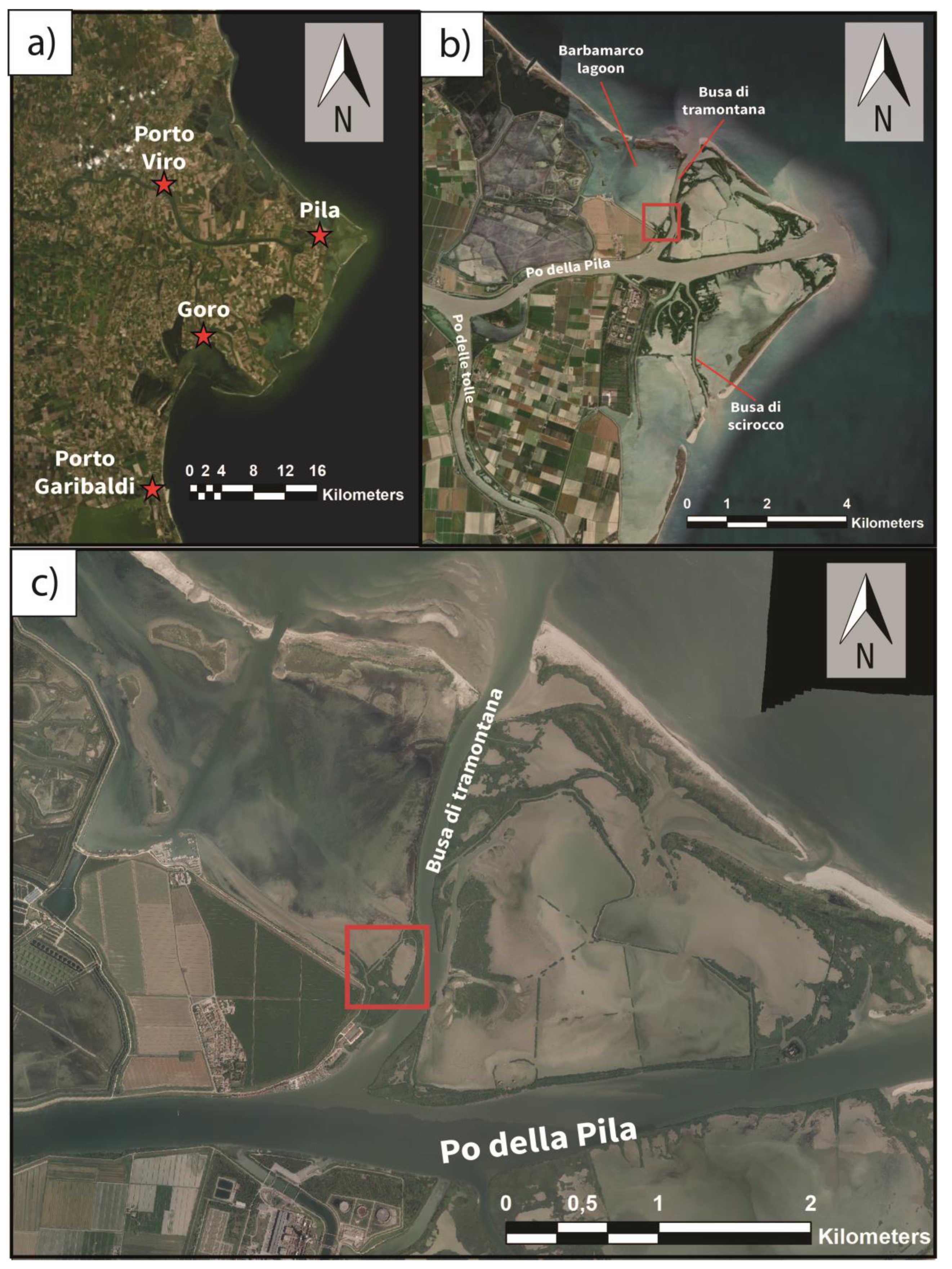
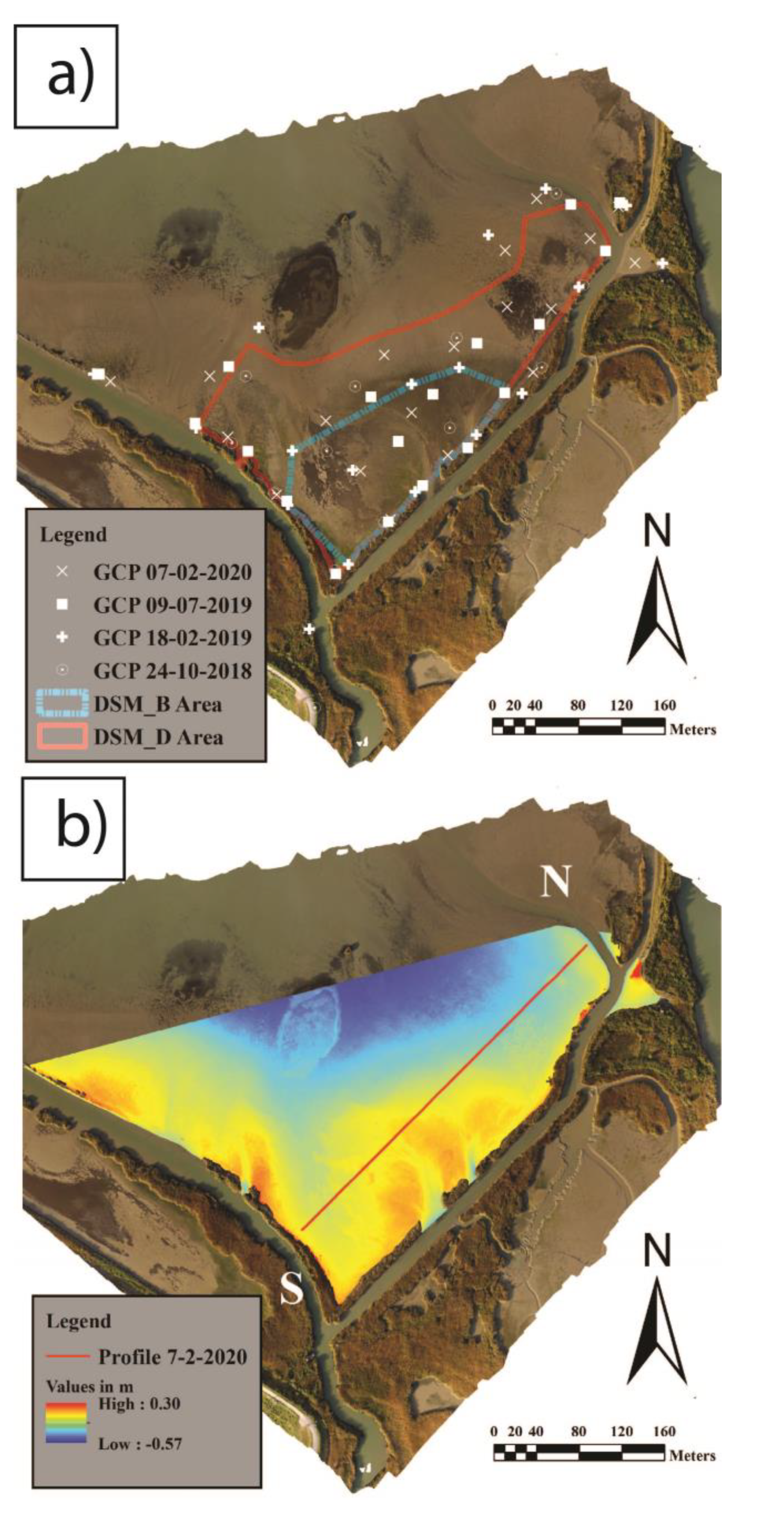
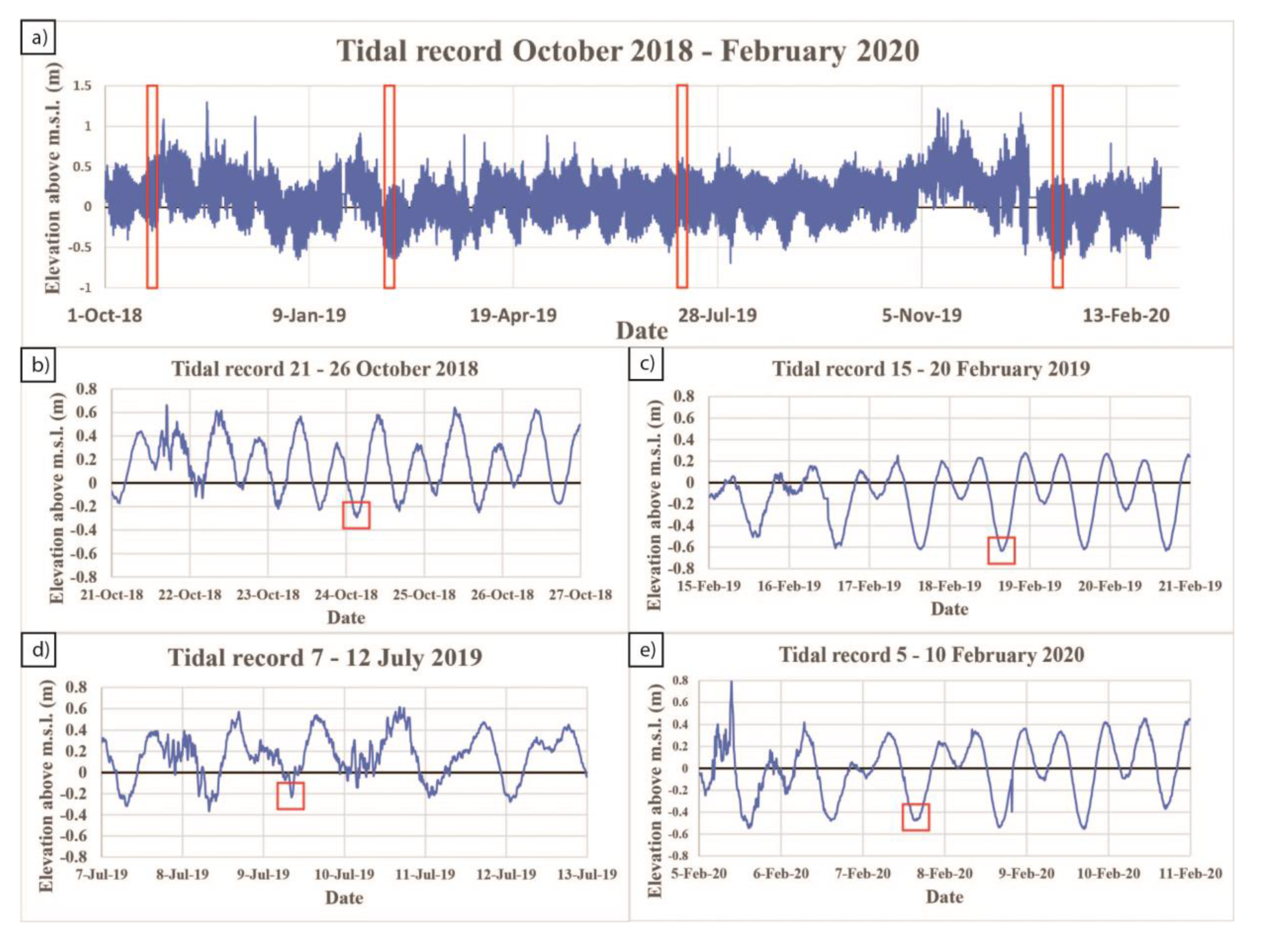
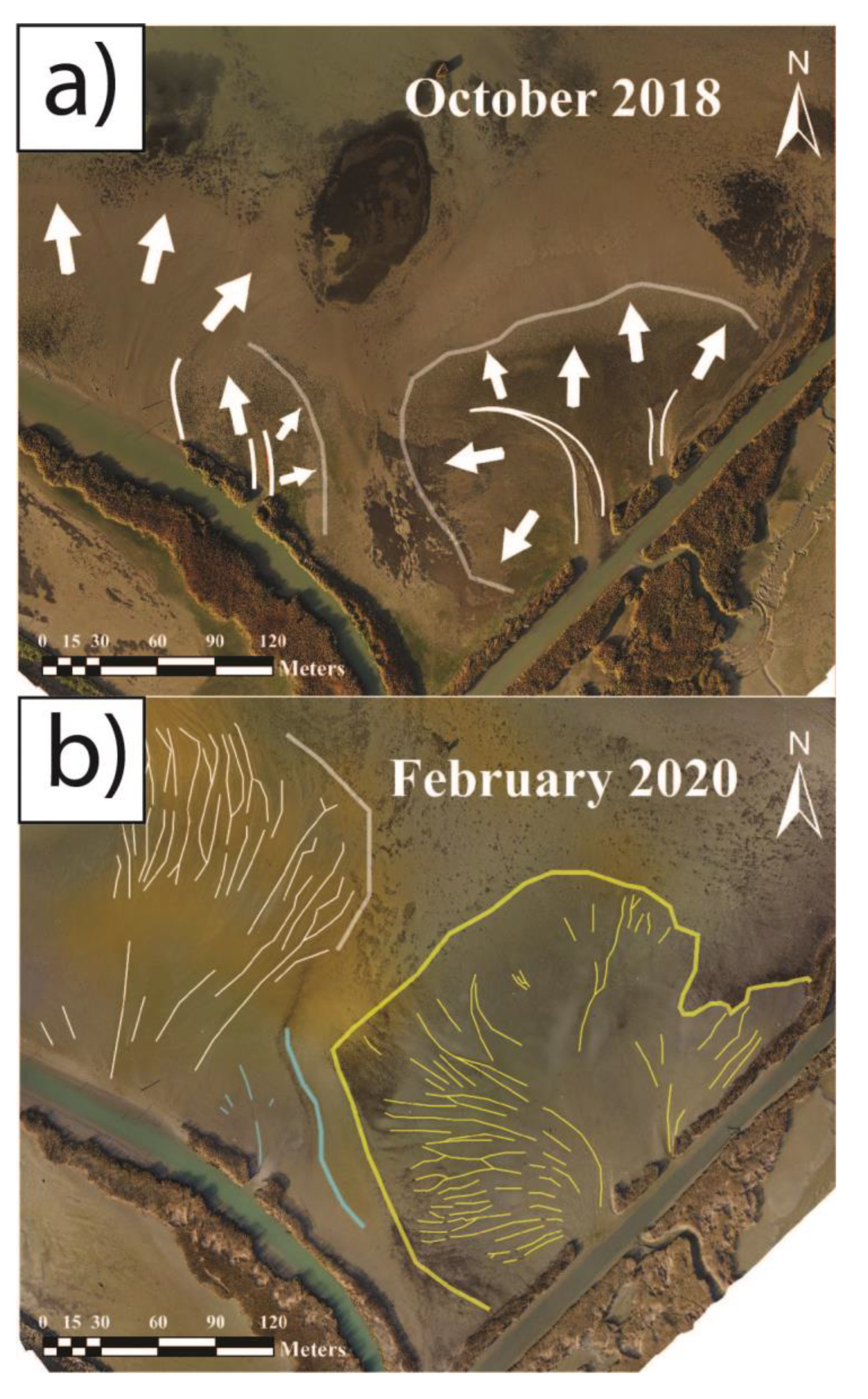
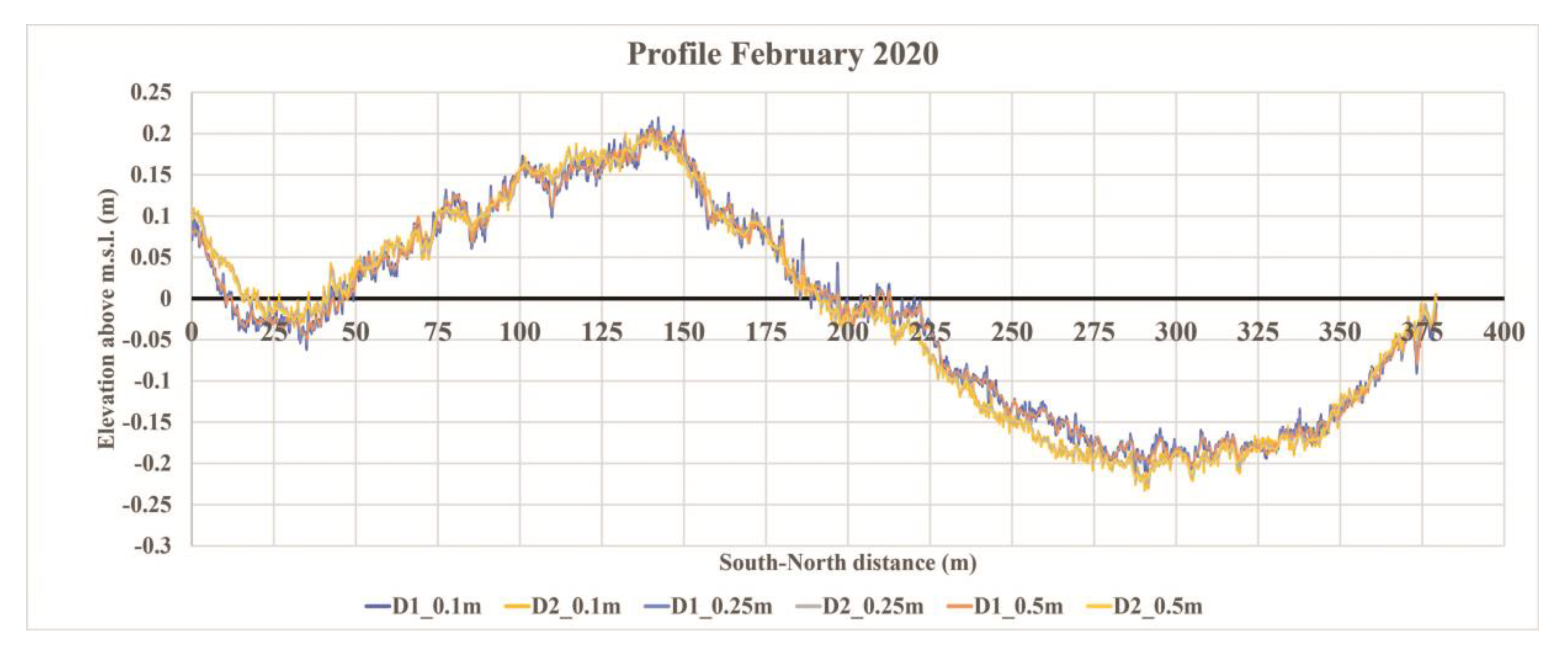
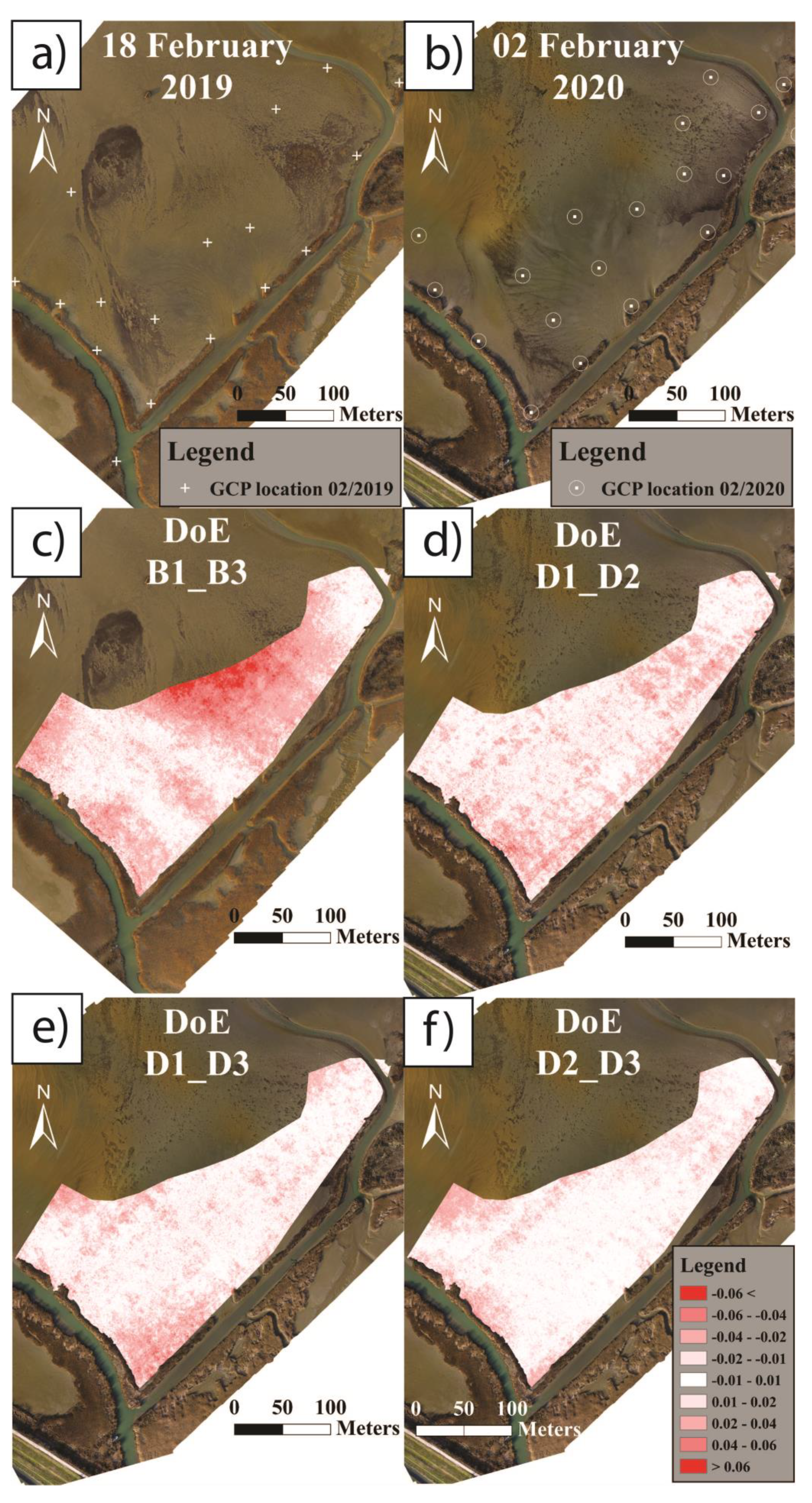

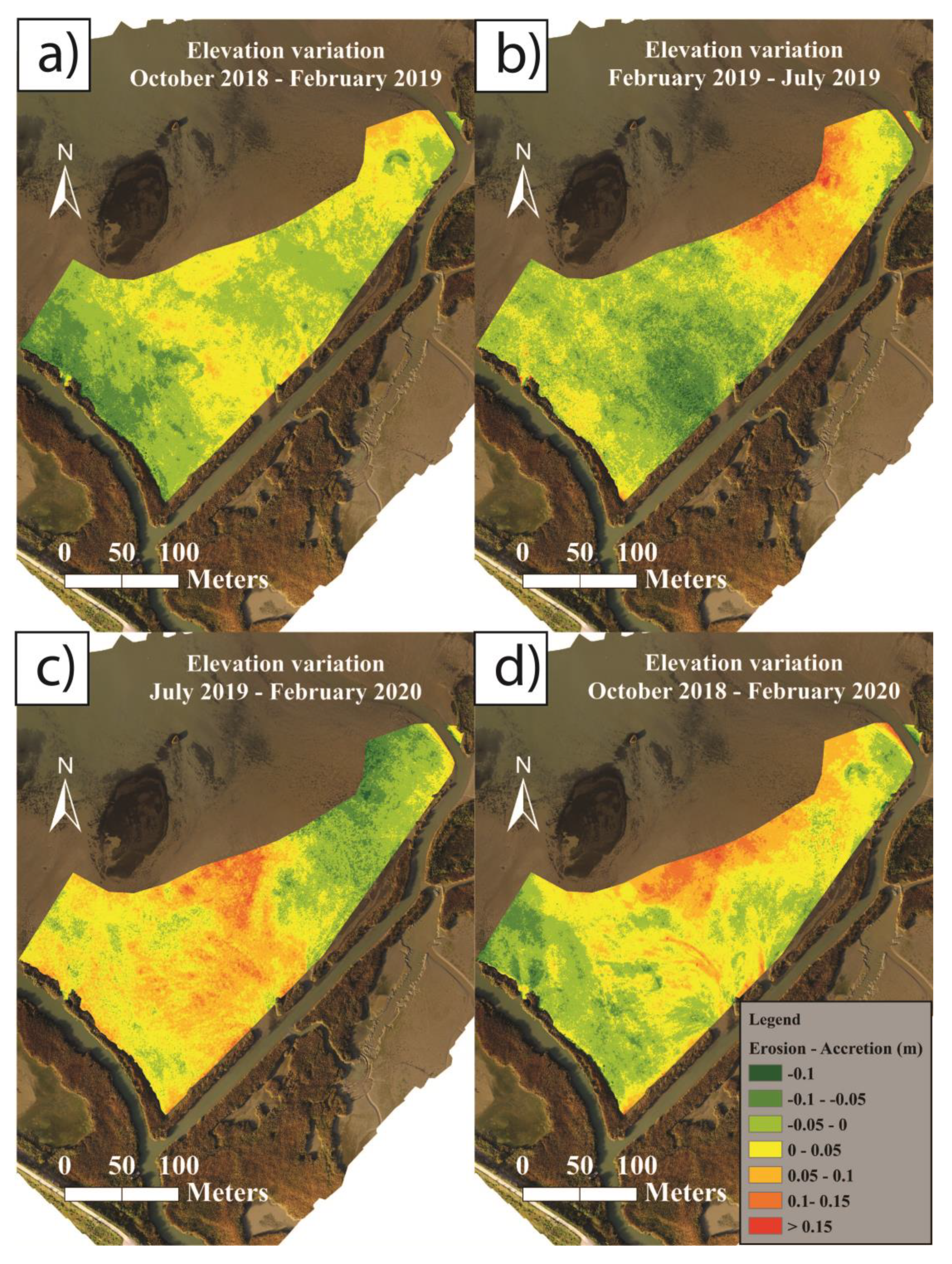

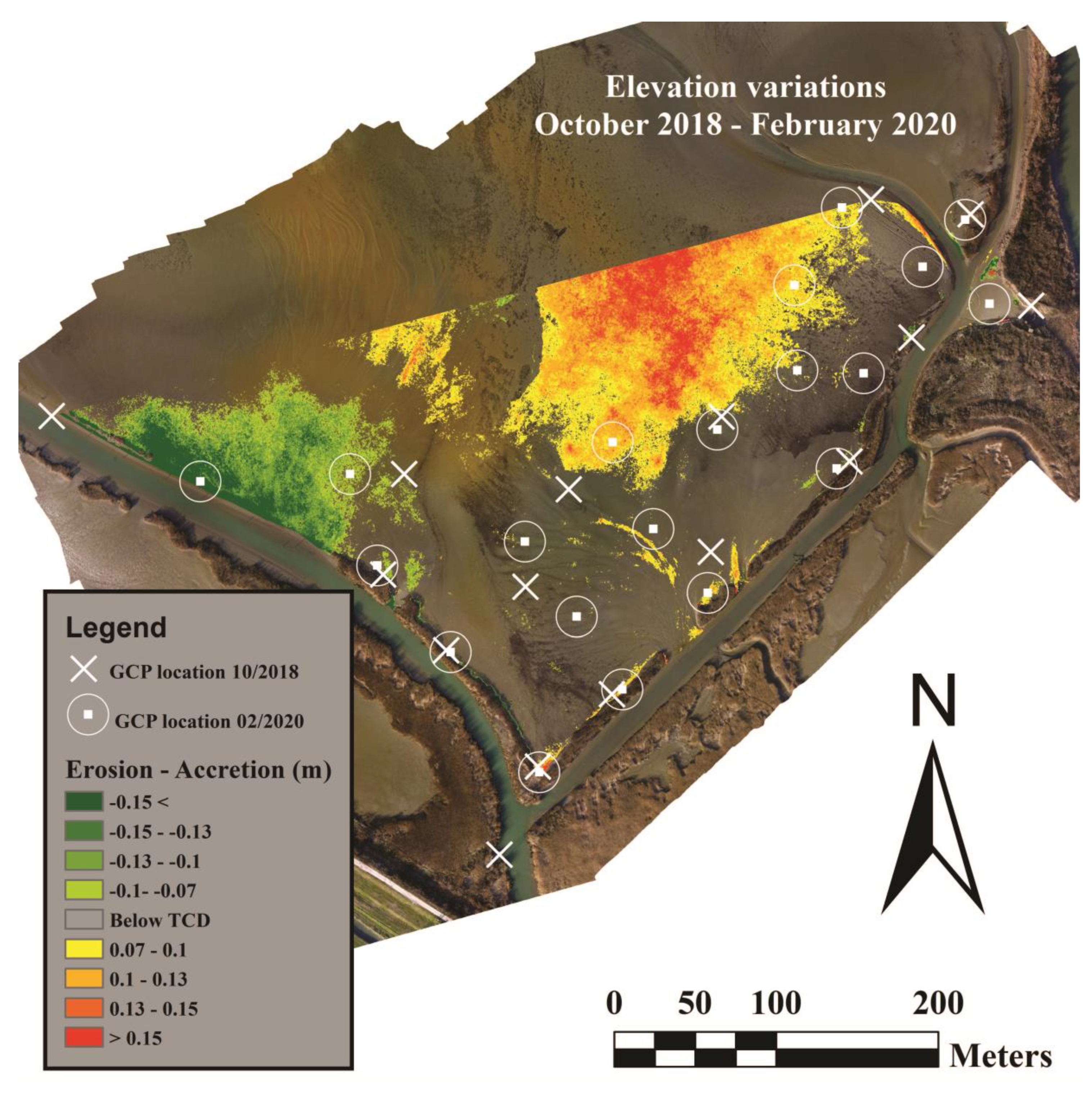
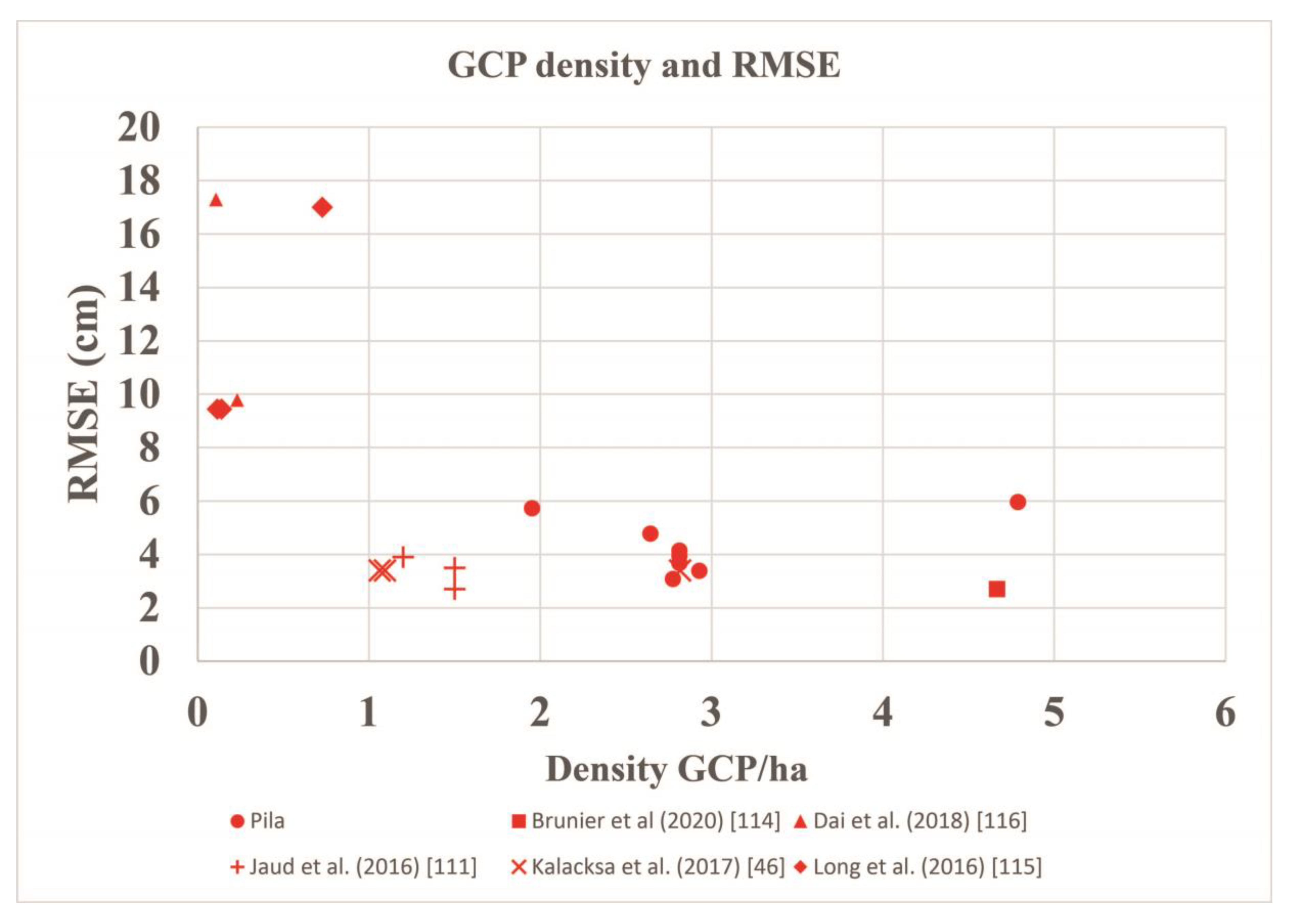
| Test ID | Date of the Surveys | Number of Images | Ground Resolution(cm/pix) | GCP | Altitude (m) | Coverage (ha) | GPS Points | Density GCP/ha | RMSE * Vs. GPS(m) |
|---|---|---|---|---|---|---|---|---|---|
| A | 24/10/2018 | 345 | 3.56 | 17 | 80 | 8.71 | 53 | 1.95 | 0.057 |
| B1 | 198 | 3.47 | 19 | 80 | 6.49 | 77 | 2.93 | 0.034 | |
| B2 | 18/02/2019 | 214 | 1.83 | 9 | 40 | 1.88 | 21 | 4.78 | 0.06 |
| B3 | 412 | 2.58 | 18 | 80 + 40 | 6.49 | 77 | 2.77 | 0.031 | |
| C | 09/07/2019 | 394 | 3.64 | 18 | 80 | 6.81 | 62 | 2.64 | 0.048 |
| D1 | 205 | 3.46 | 20 | 80 | 7.11 | 103 | 2.81 | 0.037 | |
| D2 | 07/02/2020 | 285 | 2.63 | 20 | 60 | 7.11 | 103 | 2.81 | 0.04 |
| D3 | 490 | 2.97 | 20 | 80+60 | 7.11 | 103 | 2.81 | 0.041 |
| Photogrammetric Test | Resolution [m] | RMSE [m] |
|---|---|---|
| 0.1 | 0.048 | |
| C | 0.25 | 0.047 |
| 0.5 | 0.046 | |
| 0.1 | 0.037 | |
| D1 | 0.25 | 0.037 |
| 0.5 | 0.036 | |
| 0.1 | 0.039 | |
| D2 | 0.25 | 0.039 |
| 0.5 | 0.038 |
| Comparison Between: | Resolution [m] | TCD [m] | TVV [m3] | TVVtcd [m3] |
|---|---|---|---|---|
| 0.1 | 0.05 | 668 | 13.9 ± 11.4 | |
| D1–D2 | 0.25 | 0.05 | 652 | 13.5 ± 10.6 |
| 0.5 | 0.05 | 641 | 15.1 ± 9.3 | |
| 0.1 | 0.06 | 2196 | 1194.7 ± 839.7 | |
| C–D1 | 0.25 | 0.06 | 2182 | 1175.8 ± 831.1 |
| 0.5 | 0.06 | 2150 | 1124.8 ± 802.2 | |
| 0.1 | 0.06 | 2469 | 1507.9 ± 1069.6 | |
| C–D2 | 0.25 | 0.06 | 2469 | 1503.3 ± 1069.5 |
| 0.5 | 0.06 | 2417 | 1438.3 ± 1038.9 |
| DoE ID | Area [ha] | TCD [m] | TVV [m3] | TVVtcd [m3] | TVVtcd/ TVV [%] | ASV [m2] | TAVD [m] | TAVDtcd [m] |
|---|---|---|---|---|---|---|---|---|
| B1_B3 | 4.72 | 0.05 | 1062.3 | 208.6 ± 173.3 | 20 ± 16 | 3546.3 | 0.02 | 0.06 ± 0.05 |
| D1_D2 | 0.05 | 668.3 | 13.9 ± 11.4 | 2 ± 2 | 227.1 | 0.01 | 0.06 ± 0.05 | |
| D1_D3 | 0.06 | 588.3 | 3.5 ± 2.4 | 1 ± 0 | 39.6 | 0.01 | 0.09 ± 0.06 | |
| D2_D3 | 0.06 | 475.3 | 0.9 ± 0.4 | 0 ± 0 | 6.1 | 0.01 | 0.14 ± 0.06 | |
| B1_B2 | 1.77 | 0.07 | 765.8 | 299.1 ± 251.9 | 39 ± 33 | 3599 | 0.04 | 0.08 ± 0.07 |
| B1_B3 | 0.05 | 310.9 | 6.5 ± 5.9 | 2 ± 2 | 117.7 | 0.02 | 0.06 ± 0.05 | |
| B2_B3 | 0.07 | 778 | 110.3 ± 103.5 | 14 ± 13 | 1478.7 | 0.04 | 0.07 ± 0.07 |
| Time Interval | DSMs | TCD | TVV | TVVtcd | NVV | NVVtcd | ASV | VRC | VRCtcd | |
|---|---|---|---|---|---|---|---|---|---|---|
| Period | Days | [cm] | [m3] | [m3] | [m3] | [m3] | [m2] | [cm/year] | [cm/year] | |
| Oct. 2018/ Feb.2019 | 117 | B1-A | 7 | 1298 | 229 ± 173 | −418 | 190 ± 157 | 2476 | -2.8 | −23.9 ± 2 |
| B3-A | 7 | 1587 | 482 ± 165 | 167 | 90 ± 262 | 5260 | 1.1 | −5.4 ± 15.5 | ||
| Feb. 2019/ Jul. 2019 | 141 | C-B1 | 6 | 1856 | 920 ± 647 | −94 | 191 ± 388 | 7633 | −0.5 | 6.5 ± 13.2 |
| C-B3 | 6 | 1764 | 686 ± 529 | −680 | −300 ± 416 | 8816 | −3.7 | −8.8 ± 12.2 | ||
| Jul. 2019/ Feb.2020 | 213 | D1-C | 6 | 2197 | 1195 ± 840 | 1187 | 818 ± 718 | 13,996 | 4.3 | 10 ± 8.8 |
| D2-C | 6 | 2497 | 1508 ± 1070 | 1296 | 946 ± 887 | 17,827 | 4.7 | 9.1 ± 8.5 | ||
| D3-C | 6 | 2415 | 1439 ± 1011 | 1438 | 1087 ± 889 | 16,848 | 5.2 | 11.1 ± 9 | ||
| Oct. 2018/ Feb. 2020 | 471 | D1-A | 7 | 1717 | 605 ± 435 | 674 | 421 ± 381 | 6210 | 1.1 | 5.3 ± 4.8 |
| D2-A | 7 | 1630 | 554 ± 409 | 783 | 355 ± 350 | 5843 | 1.3 | 4.7 ± 4.6 | ||
| D3-A | 7 | 1745 | 661 ± 471 | 925 | 496 ± 425 | 6728 | 1.5 | 5.7 ± 4.9 | ||
| Average Flow Discharge (m3/s) | |
| Mean | 1592.6 |
| St. Deviation | 1191.8 |
| Min | 556.7 |
| Max | 8011.8 |
| Hydrometric Level (m) | |
| Mean | −4.07 |
| St. Deviation | 1.84 |
| Min | −6.19 |
| Max | 2.7 |
| Location | Author | Average Vertical Rate of Change [cm/year] | Mean Tidal Range [m] | Monitoring Period [years] |
|---|---|---|---|---|
| Pila (Po Delta) (IT) | This study | 1.3 (5.2 ± 4.8) * | 0.5 | 1.3 |
| Venice Lagoon (IT) | Day et al. (1998) Ciavola et al. (2002) Scarton et al. (2006) | 0.3 | 0.8 | - |
| Kongsmark, Rømø Bight (DNK) | Andersen et al. (2006) | 1.5 | 1.8 | 8 |
| North Carolina, Orgeon Inlet, Jacob’s Creek (USA) | Craft et al. (1993) | 0.5 | 0.3 | 25 |
| Texas, Bayhead Plain (USA) | White et al. (2002) | 0.51–0.33 | 1< | >100 |
| Louisiana, Deltaic Plain (USA) | Hatton et al. (1983) Jankowsky et al. (2017) | 1.3–0.4 | 1< | >6 |
| Florida, Waccassa Bay (USA) | Wood and Hine (2007) Goodbred and Hine (1995) | 0.2 | 1.2 | >100 |
| New York, Hudson River, (USA) | Yellen et al. (2020) | 0.6–1.1 | 1.2 | >100 |
| Rhone Delta (FR) | Hensel et al. (1999) | 1.1 | 0.3 | 4 |
| Ebro Delta (ES) | Ibanez et al. (2010) | 0.1–0.6 | 0.2 | 3–9.5 |
| Author | Drone model | Camera | Focal [mm] | Coverage [ha] | Number of images | GCP | Speed [m/s] | Altitude [m] | RMSE [cm] | DGPS [m] | Overlap (front-side) | Density [GCP/ha] |
|---|---|---|---|---|---|---|---|---|---|---|---|---|
| This study | DJI Phantom visual 3+ | FC300X | 3.61 | 8 | 198-490 | 17-19- 18-20 | 8-10 | 40-60-80 | 3-6 | 0.03 | 70 | 1.9-2.8-4.9 |
| Brunier et al. (2020) | DJI F550 | RICOH GR | 18.3 | 3 | 265 | 14 | - | 18 | 2.7 | 0.03 | 90-60 | 4.667 |
| Dai et al. (2018) | DJI MATRICE 600 | Zenmuse X5 | 15 | 26-37 | 1219- 1360 | 6-4 | 5 | 80 | 9.79-17.30 | 0.005-0.01 | - | 0.231-0.108 |
| Jaud et al. (2016) | DroneSys DS6 DRELIO | Nikon D700 | 35 | ~10 | 316-168- 247 | 12-15- 15 | 3 | 100 | 3.9-2.7-3.5 | 0.03-0.04 | 60 | 1.2-1.5 |
| Kalacska et al. (2017) | DJI Inspire 1 | X3 FC350 | 20 | 4.26-5.49-8.46 | 274-182- 390 | 12-6-9 | 1.16 | 30 | 3.4 | 0.02 | 90-80 | 2.817-1.093-1.064 |
| Kim et al. (2019) | Vision-1000 | Canon 6D DSLR | 17 | 250 | 305 | 11 | Automatic | 180 | 5 m | - | 60-70 | 0.044 |
| Long et al. (2016) | eBee flying wing | Canon ELPH110HS RGB | 4.3-21.5 | 400-33 | 672-643- 301 | 46-56- 24 | 6-10-2 | 150-150-50 | 9.44-17 | - | 75-60 | 0.115-0.140-0.727 |
Publisher’s Note: MDPI stays neutral with regard to jurisdictional claims in published maps and institutional affiliations. |
© 2021 by the authors. Licensee MDPI, Basel, Switzerland. This article is an open access article distributed under the terms and conditions of the Creative Commons Attribution (CC BY) license (https://creativecommons.org/licenses/by/4.0/).
Share and Cite
Brunetta, R.; Duo, E.; Ciavola, P. Evaluating Short-Term Tidal Flat Evolution Through UAV Surveys: A Case Study in the Po Delta (Italy). Remote Sens. 2021, 13, 2322. https://doi.org/10.3390/rs13122322
Brunetta R, Duo E, Ciavola P. Evaluating Short-Term Tidal Flat Evolution Through UAV Surveys: A Case Study in the Po Delta (Italy). Remote Sensing. 2021; 13(12):2322. https://doi.org/10.3390/rs13122322
Chicago/Turabian StyleBrunetta, Riccardo, Enrico Duo, and Paolo Ciavola. 2021. "Evaluating Short-Term Tidal Flat Evolution Through UAV Surveys: A Case Study in the Po Delta (Italy)" Remote Sensing 13, no. 12: 2322. https://doi.org/10.3390/rs13122322
APA StyleBrunetta, R., Duo, E., & Ciavola, P. (2021). Evaluating Short-Term Tidal Flat Evolution Through UAV Surveys: A Case Study in the Po Delta (Italy). Remote Sensing, 13(12), 2322. https://doi.org/10.3390/rs13122322






